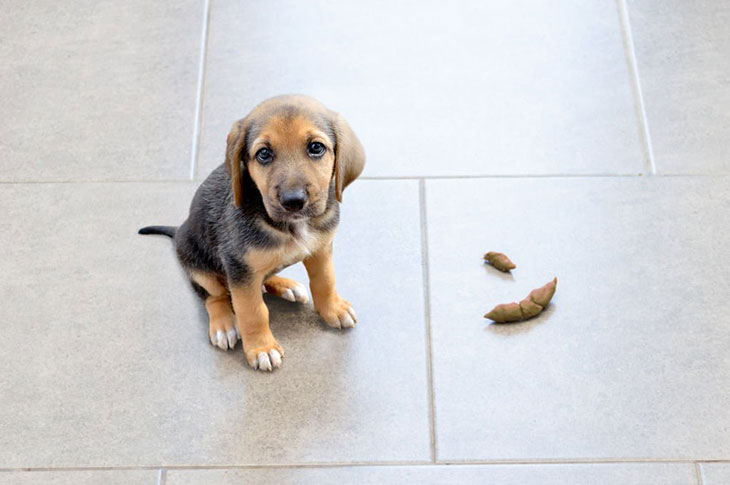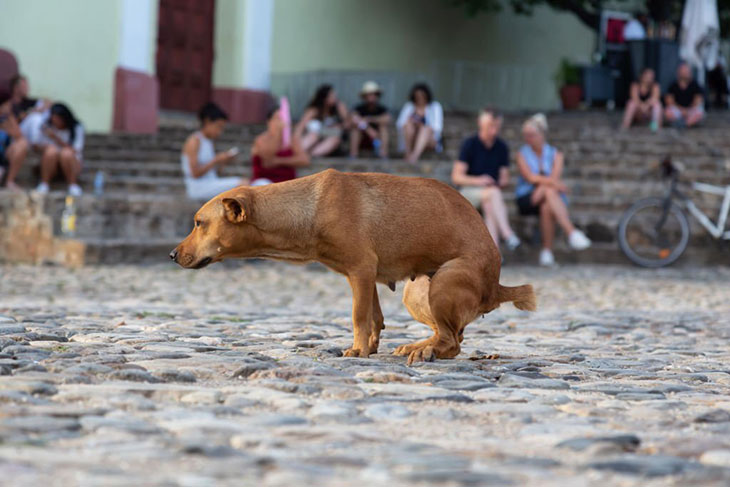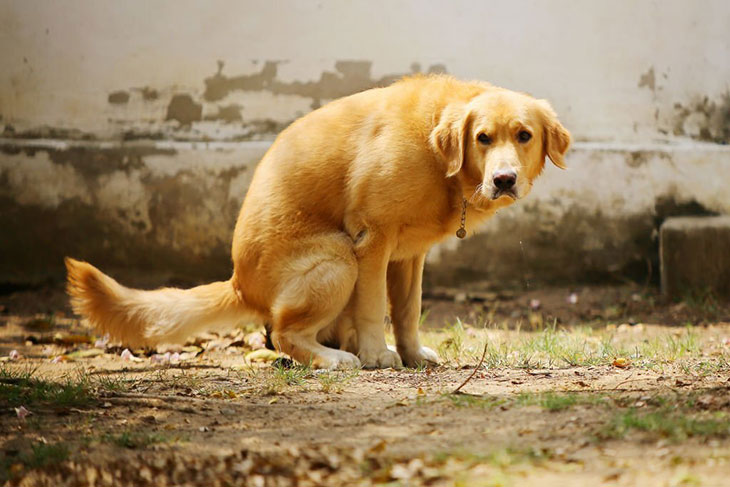Are you perplexed as to why your dog keeps squatting after pooping? Come along with us as we investigate the mystery around this odd behavior.
In this article, we dig into the interesting world of dogs and examine the causes of their post-poop squat.
Get ready for an insightful investigation of the distinctive characteristics of your dog.
Reasons For Dog Keeps Squatting After Pooping

The reasons for this problem can vary. It may be due to gastrointestinal upset, stomach ailments, colitis, or diarrhea.
Exploring these common reasons can help shed light on your dog’s behavior and provide insight into its overall well-being.
Gastrointestinal (GI) Upset
Gastrointestinal (GI) upset is the main reason dogs may continue squatting after pooping. GI problems in dogs can cause discomfort and insufficient evisceration.
To relieve this discomfort, dogs may instinctively squat again to empty their intestines thoroughly. It does not necessarily imply they are attempting to do away with it.
Scientists are investigating the millions of neurons in the gastrointestinal tract, popularly known as the second brain.
An underlying digestive issue may cause continuous GI upset and chronic squatting.
Stomach Ailments
Stomach health issues are another reason a dog might continue to squat after pooping. Dogs who have these problems may develop urinary tract infections.
Even after having a bowel movement, this discomfort may persist, causing individuals to squat once more to feel better.
A stomach sickness can interfere with the intestinal worms and digestive tract’s normal operation, leading to erratic bowel motions or uneasy reasons for stomach issues, including intestinal parasites, infections, celiac disease, and irritable bowel syndrome.
Colitis
Another possible explanation for dog squatting but not pooping is colitis, which is colonic inflammation.
The symptoms of this illness include discomfort, urgency, and frequent bowel motions.
Dogs with colitis may still need to squat after a bowel movement because of the ongoing inflammation in their colon.
Continuous discomfort can impair regular bowel movements, leading to incomplete eviction and the need to squat once more.
Pet owners can spot the symptoms by knowing how colitis may lead to post-poop squatting behavior.
Since colitis is the underlying source of the symptoms, a completely different course of treatment would be necessary.
Your doctor might suggest you start treating your dog’s colitis with metronidazole if they have it.
Diarrhea
Dogs frequently experience diarrhea, which can be a major contributing factor to dog squats to poop but doesn’t.
Dogs who have diarrhea have loose, frequent bowel motions.
Dogs may still feel the urge to squat after having a bowel movement because of the persistent urgency brought on by diarrhea.
The need for repeated squatting can result from the body’s desire to remove more waste and incomplete bowel emptying, and anal gland issues.
Dogs with colitis experience diarrhea first, followed by a steady decrease in the amount of liquid excrement they generate.
You may need to see a vet right away if your dog not only has diarrhea but the output is mostly clear liquid, and you notice that your dog appears to be trying to poop.
Tenesmus
Your dog may have tenesmus if he tries and tries to create something but fails.
Even when little to no feces are left in the rectum, dogs with tenesmus may repeatedly squat or try to urinate. The watery dog poop may contain blood and mucus.
Dogs may squat again to relieve discomfort and the feeling of incomplete expulsion. Tenesmus is strained, and only small amounts of diarrhea are coming out.
It’s critical to distinguish between the two since diarrhea in dogs and constipation require entirely different approaches to therapy.
Constipation
Constipation is sometimes a major factor if the dog keeps squatting but not pooping. A dog’s bowel motions become infrequent and challenging when they are constipated.
Dogs may still feel the urge to squat even after having frequent bowel movements because of the lingering feeling of incomplete expulsion.
Constipation can cause continuous discomfort that can cause the body to squat repeatedly for the stool softeners.
Constipation can affect any dog breed, size, or age, but it is more prevalent in older dogs. Even while it doesn’t require an urgent doctor trip, constipation can worsen into a serious condition.
How To Treat This Issue?

Change The Diet
A possible treatment for this problem is to modify their diet. Diet is essential for preserving a healthy digestive system.
Pet owners can aid their dog’s bowel movements by choosing a meal high in fiber and simple to digest.
High-fiber diets encourage regularity and make a dry stool, which makes it simpler for dogs to eliminate waste.
A diet free of potential allergens or irritants can also lessen inflammation and enhance digestive health conditions. You must stay away from a lack of fiber and digestible food.
You can use canned pumpkins and fresh water.
Generally speaking, you may see your dog continuing to try to defecate after already doing so if you have changed your pup’s diet, mealtimes, or other external circumstances.
Exercise
Regular and plenty of exercise is an effective remedy for the problem of dog squats for a long time to poop.
Participating in physical activities with your pet helps to stimulate their digestive system and encourages regular bowel movements.
Exercise prompts abdominal muscular activity, which facilitates the easy passage of waste through the intestines.
Additionally, it aids in controlling how the entire gastrointestinal tract operates.
Further, exercise stimulates the body and mind. Your veterinarian might also advise you to give your dog more activity for a couple of days to see if that helps.
Your dog’s routine can be improved by including regular walks, playing, and interactive games in order to encourage healthy digestion, lessen post-poop squatting, and generally improve their well-being.
Relaxation
Another good strategy is to provide your dog with a peaceful atmosphere.
Stress and worry can impair the digestive system’s ability to operate normally, resulting in erratic bowel movements and a persistent urge to squat.
If you create a serene and stress-free environment, your furry friend will feel better during and after their restroom routine.
Establish a dedicated, distraction-free location where they can relieve themselves.
Please don’t sit back and watch him try to urinate while acting like you have all the periods of time in the world.
Stress levels can be decreased by incorporating relaxation techniques like calming music, aromatherapy, or gentle massage.
See A Vet
Even after attempting numerous fixes, if your dog still squats to help the passage of stool, it might be time to see a vet for advice.
Identification of any underlying medical condition requires seeing a veterinarian.
To identify the underlying cause, a veterinarian will undertake a thorough examination that may include diagnostic tests.
They can offer specialized care alternatives, such as medications or special meals, that are catered to your dog’s individual requirements.
FAQs

Why Does My Dog Keep Squatting Like He Has To Poop?
Due to gastrointestinal problems, discomfort, and incomplete evisceration, your dog may continue to squat as if he needs to poop.
The precise cause can be ascertained by consulting a veterinarian.
Why Does My Dog Keep Squatting But Not Pooping?
Constant squatting without healthy poop in your dog could indicate digestive problems. These ailments may result in discomfort and an unsuccessful urge to urinate.
Can Milk Help Dogs With Constipation?
Milk is not suggested as a treatment for constipation in dogs. While it occasionally may have a laxative effect, it can also upset the stomach.
For the best course of action, speak with a veterinarian.
Conclusion
We’ve looked at the causes behind the puzzling habit of dog keeps squatting after pooping.
My canine pals have specific methods of communicating discomfort, from digestive upset to stomach disorders, colitis, to constipation.
But don’t worry; we can get out of this tricky situation. Remember that a healthy dog wags its tail, not the standard dog squat.
